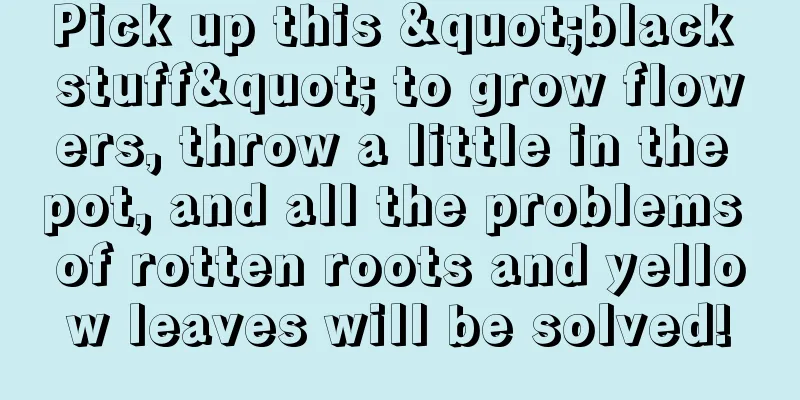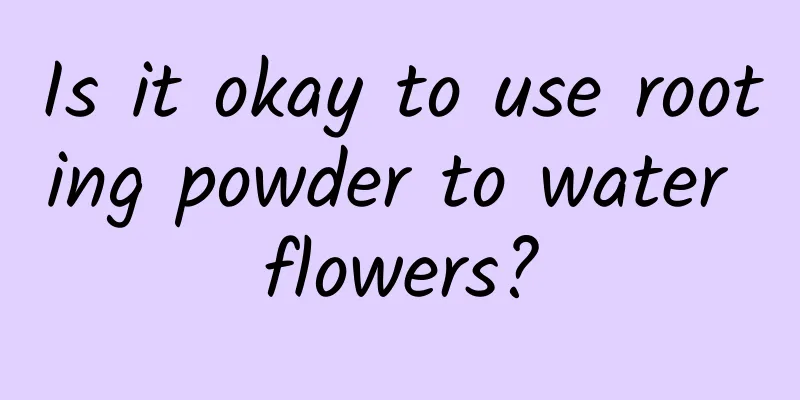Pick up this "black stuff" to grow flowers, throw a little in the pot, and all the problems of rotten roots and yellow leaves will be solved!

|
Generally speaking, when flower plants have yellow leaves and rotten roots, it is mostly because of problems in maintenance methods, and lack of nutrients is the main reason. After all, plants and flowers need sufficient nutrients to ensure their growth during the growth process, but the nutrients in the soil are limited. At this time, we need to use some small things to help the plants add nutrients and resume growth. In fact, if there is a lack of nutrients during the flower-growing process, we don’t necessarily have to buy flower fertilizers to help supplement nutrition. Sometimes some small items in life may seem insignificant, but they can play a big role in growing flowers, just like these "black things" that Huahua knows. Usually no one wants them on the roadside. Picking some up and taking them home to grow flowers is no worse than flower fertilizer! Willow barkNow it is winter, and many trees are beginning to shed their leaves and bark, and willow trees are naturally among them. At this time, we can collect some willow bark and take it home as a backup for growing flowers. Willow is a plant that can survive as long as it comes in contact with water. This is entirely because it contains a relatively rich amount of salicylic acid, which can accelerate cell division and thus promote growth. Similarly, we can achieve the same effect by using willow bark to grow flowers. Directions:We cannot use willow bark directly. It needs to be sterilized at high temperature to avoid problems in the future. We first soak the collected willow bark in boiling water for a few hours, and then take it out and mix it with the soil to enhance nutrients and looseness, or directly place it at the bottom of the flowerpot as base fertilizer. It is a good choice. In this way, the nutrients in it will slowly evaporate, which will naturally help the plant increase its growth rate. The second type: pine needlesHuahua just said that trees shed their leaves in winter, and pine needles are also common sights on the roadside at this time. Although these tiny pine needles may seem insignificant, because they are hard in texture and belong to the pine family, they can be used to help grow flowers, not only enhancing soil permeability but also providing nutrients. Directions:Because pine needles are collected outdoors, they naturally cannot be used directly. They need to be exposed to the sun for a period of time to completely remove the impurities and bacteria inside. They can then be mixed with soil to make pine needle soil, or they can be spread on the surface or bottom of the soil in the flowerpot to improve drainage and help growth. These two inconspicuous black things may not seem to have much use, but they are just right for growing flowers. Have you all learned today’s little method of growing flowers? |
Recommend
The efficacy and function of Jasper
1. The value of history In the earliest times, it...
How to care for goldenrod potted plants
1. The habit of this plant Because it is a tropic...
What flowers are suitable for the elderly?
honeysuckle Honeysuckle can be made into a small ...
What plants represent courage and strength?
1. Cactus The flower language of cactus is streng...
Disease and insect pest control of firecracker flower
Possible pests and diseases The firecracker plant...
The difference between cat's eye arrowroot and peacock arrowroot
1. Difference in appearance Cat's eye arrowro...
How to deal with rhododendron root rot
1. Remove the plant Regardless of whether the aza...
How to quickly root hyacinth
1. Processing bulbs Its reproduction is usually c...
Which month is best to plant tulips?
Tulips are a kind of flower plant that many frien...
When is the best time to plant southern Chinese cabbage?
Planting time of Chinese cabbage in the south Chi...
How many years does the golden marble tree bear fruit?
Introduction to Planting Golden Marble Tree The g...
How often should orange trees be fertilized and what kind of fertilizer should be applied?
How often should you fertilize your orange tree? ...
Does chrysanthemum tea have weight loss effects?
1. Reasons Chrysanthemum tea has many functions, ...
Zibao's family breeding methods and precautions
1. Lighting Zibao likes light, so it should be pl...
How to grow aloe vera quickly
1. Suitable soil If you want the plants to grow f...









